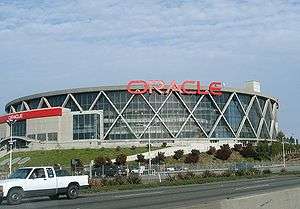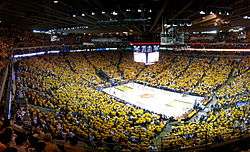Oracle Arena
| Oakland Coliseum Arena | |
 | |
 | |
| Former names |
Oakland–Alameda County Coliseum Arena (1966–1996) The Arena in Oakland (1997–2005) Oakland Arena (2005–2006) |
|---|---|
| Address | 7000 Coliseum Way |
| Location | Oakland, California |
| Coordinates | 37°45′1″N 122°12′11″W / 37.75028°N 122.20306°WCoordinates: 37°45′1″N 122°12′11″W / 37.75028°N 122.20306°W |
| Public transit |
|
| Owner | Oakland–Alameda County Coliseum Authority |
| Operator | AEG |
| Capacity |
Basketball: 19,596 Concert: 20,000 Ice hockey: 13,601 (1966–1997), 17,200 (1997–present) |
| Construction | |
| Broke ground | April 15, 1964 |
| Opened | November 9, 1966 |
| Renovated | 1996–1997 |
| Construction cost |
US$24 million (original)[1] $121 million (1996–97 renovation) |
| Architect |
Skidmore, Owings and Merrill[1] HNTB (renovation) |
| General contractor | Guy F. Atkinson Company[1] |
| Tenants | |
|
Golden State Warriors (NBA) (1966–1967, 1971–2019) California Seals (WHL) (1966–1967) Oakland Oaks (ABA) (1967–1969) California Golden Seals (NHL) (1967–1976) San Francisco Golden Gaters (WTT) (1974–1978) Golden Bay Earthquakes (NASL/MISL) (1982–1984) Oakland Skates (RHI) (1993–1995) California Golden Bears (NCAA) (part-time 1966–1996, full-time 1997–1999) | |
Oracle Arena is an indoor arena located in Oakland, California, United States, and is the home of the Golden State Warriors of the National Basketball Association (NBA). The arena opened in 1966 and is the oldest arena in the NBA. From its opening until 1996 it was known as the Oakland–Alameda County Coliseum Arena. After a major renovation completed in 1997, the arena was renamed The Arena in Oakland until 2005 and Oakland Arena from 2005 to 2006. It is often referred to as the Oakland Coliseum Arena as it is located adjacent to the Oakland–Alameda County Coliseum. Oracle Arena seats 19,596 fans for basketball and 17,200 for ice hockey.
History
Home franchises
The arena has been the home of the Golden State Warriors[2] since the 1971–72 season, except the one-year hiatus while the arena was undergoing renovations. It had been used by the Warriors intermittently as early as 1966. The California Golden Bears of the Pac-10 played the 1997–98 and 1998–99 seasons at the arena while their primary home, Harmon Gym, was being renovated into Haas Pavilion. For some years before then, the Bears played occasional games against popular non-conference opponents at the arena.
Oracle Arena has been home to Warriors playoff games in 1972, 1973, 1975, 1976, 1977, 1987, 1989, 1991, 1992, 1994, 2007, 2013, 2014, 2015, 2016, 2017, and 2018.[3] It hosted the 2015, 2016, 2017, and the 2018 NBA Finals, where the Warriors won in 2015, 2017, and 2018. The 2015 victory was the first time since 1975 the Warriors won the title; however, Games 2 and 3 of the 1975 NBA Finals were played in the Cow Palace as the Coliseum was unavailable. The 2017 victory was the first time that a San Francisco Bay Area team won a title in their home venue since the Oakland Athletics in the 1974 World Series.
The arena's first tenants were the California Seals of the Western Hockey League, who moved across the bay from the Cow Palace in 1966. The owners of the San Francisco Seals had been awarded an expansion franchise in the National Hockey League on the condition they move out the Cow Palace and into the then-new Oakland Coliseum Arena. The team changed its operating name from San Francisco Seals to California Seals in order to draw fans from both San Francisco and Oakland. The Seals franchise continued to play at the arena after having transferred to the NHL, until the team moved to Cleveland after the 1975–76 NHL season.[4]
The Coliseum also hosted the American Basketball Association's Oakland Oaks (1967–1969), a charter member of the new ABA in 1967. The Oaks signed San Francisco Warriors star Rick Barry away from the rival National Basketball Association in 1968. The team was owned by entertainer Pat Boone and also had stars Larry Brown and Doug Moe on its roster. Brown and Barry are in the Basketball Hall of Fame. After a 22–56 record in their first season, the Oaks went 60–18 during the regular season in 1968–69. The Oaks then defeated the Denver Rockets, New Orleans Buccaneers and finally the Indiana Pacers in the playoffs to capture the ABA Championship. However, the team was plagued by poor attendance and Boone sold the team following their ABA Championship. They were relocated to Washington and became the Washington Caps.[5]
The Bay Bombers (Roller Derby, 1966–1973) as well as the Golden Bay Earthquakes of the original MISL during the 1982–83 season and the Oakland Skates, a professional roller hockey team active from 1993 to 1995, all played there. WWE also holds professional wrestling matches at the arena.
Renovation
Over three decades, the arena grew outdated, lacking the luxuries of newer ones. With just over 15,000 seats, it was one of the smallest venues in the league. Rather than building a new arena in Oakland, San Francisco or San Jose, the decision was made to proceed with a US$121 million renovation that involved tearing out much of interior and building a new seating bowl within the existing structure. The original walls, roof and foundation remained intact, similar to the rebuild of KeyArena in Seattle. The renovation began in mid-1996 and was completed in time for the Warriors return in the fall of 1997 (they played the previous season at the San Jose Arena, home of the NHL's Sharks). Included in the renovation was a new center overhead LED scoreboard and 360-degree fascia display. The new configuration seats 19,596 for basketball and 17,200 for ice hockey.
The Oracle
On October 20, 2006, the Golden State Warriors and Oracle Corporation announced that the Oakland Arena would be known as The Oracle for a 10-year term. A press conference was held on October 30.[6] "The O", as it is referred to, continued to be managed by Oakland–Alameda County Authority (JPA) and SMG. The JPA approved the deal at its November 10 meeting.[7]
Oracle Arena has, at least since 2013, been one of the loudest arenas in the NBA. It is called "Roaracle" because of the painfully high decibel levels sometimes generated at Warriors games. The Warriors will play their final regular season home game on April 7, 2019 against the Los Angeles Clippers, and the team's lease is set to expire by the end of June 2019.[8] The Final Concert at Oracle Arena Will be Shawn Mendes on July 13, 2019.
Attendance records

On May 13, 2007, 20,679 fans watched the Warriors lose to the Utah Jazz 115–101 in Game 4 of the Western Conference semifinals. This was the highest attendance in the Warriors' 61-year history.
That record lasted until December 14, 2007, when the Warriors hosted the Los Angeles Lakers and packed 20,705 into the Arena to set a new franchise attendance record.
The record was again broken on February 20, 2008, when the arena hosted 20,711 for the Warriors-Celtics game.[9]
This record was set yet again on April 10, 2008, when Oracle Arena hosted 20,737 fans in a Warriors loss to the Denver Nuggets.[10]
By the end of the 2016–17 regular season, Oracle had sold out 230 consecutive home games, a streak that continued throughout the team's playoff run. Oracle drew over 18,000 people per game for 12 straight seasons.[11]
The Grateful Dead
The Grateful Dead played more concerts (66) at this venue than at any other,[12][13] and their December 16, 1992 concert at the arena was released as Dick's Picks Volume 27, along with bonus tracks from their December 17, 1992 concert at the arena.
Future
Early in 2013, the Warriors announced they would build a new arena in San Francisco and move back to the city.[14] It was originally suggested that the arena would be built on the decaying sites of Piers 30–32 near the foot of the Bay Bridge,[14] but the plan was met with opposition due to concerns about traffic, environmental impacts and obstruction of views.[15] In April 2014, the Warriors purchased 12-acres in Mission Bay as the site for a new 18,000-seat arena planned to open for the 2018–19 NBA season.[16] The new location eliminated the need for voter approval, which would have been required for the original site, though it had been unanimously approved by the San Francisco Supervisors in November 2012.[17] Because of delays due to litigation filed by arena opponents it is now planned to open at the start of the 2019–20 NBA season.[18] The new arena will be named the Chase Center.[19]
Seating capacity

The seating capacity for basketball has expanded from 13 to 19 thousand in over a half-century of use:[20]
| Years | Capacity |
|---|---|
| 1966–1972 | 13,502 |
| 1972–1973 | 12,905 |
| 1973–1974 | 13,123 |
| 1974–1976 | 12,787 |
| 1976–1977 | 13,155 |
| 1977–1980 | 13,237 |
| 1980–1982 | 13,239 |
| 1982–1984 | 13,335 |
| 1984–1985 | 13,295 |
| 1985–1986 | 15,011 |
| 1986–1997 | 15,025 |
| 1997–present | 19,596 |
References
- 1 2 3 "PCAD - the Pacific Coast Architecture Database - Home". digital.lib.washington.edu.
- ↑ Suppes, BALLPARKS.com by Munsey and. "Oracle Arena". basketball.ballparks.com.
- ↑ "Golden State Warriors Playoff History - RealGM". basketball.realgm.com.
- ↑ Suppes, BALLPARKS.com by Munsey and. "Oakland/Alameda Coliseum". hockey.ballparks.com.
- ↑ "Remember the ABA: Oakland Oaks". www.remembertheaba.com.
- ↑ "Warriors, ORACLE Formally Announce Naming Rights Agreement For ORACLE Arena - Golden State Warriors".
- ↑ "Golden State Warriors, Oracle Reach Arena Naming Rights Agreement - Golden State Warriors".
- ↑ "Hey Roaracle", May 21, 2013, Retrieved May 26, 2018
- ↑ "Baron Davis hits last-second jumper in Warriors' 119–117 win over Celtics". The San Francisco Chronicle. Archived from the original on 2008-12-10.
- ↑ Jeff Maus (August 20, 2010). "Next for the Warriors: The Oakland Warriors? Or San Francisco Bound?". Bleacher Report.
- ↑ "Warriors Conclude 2016-17 Regular Season with 230 Consecutive Sellouts". www.nba.com/warriors. April 12, 2017.
- ↑ "The SetList Program - Grateful Dead Setlists, Listener Experiences, and Statistics". www.setlists.net.
- ↑ "venues". www.deadlists.com.
- 1 2 Matier, Phillip (February 15, 2013). "Warriors to build new arena, move back to S.F." San Francisco Chronicle (SF Gate). Retrieved 8 May 2014.
- ↑ Knight Perrigan, Heather (May 22, 2012). "Golden State Warriors owners make a risky play". The San Francisco Chronicle. Retrieved May 22, 2012.
- ↑ Cote, John (April 22, 2014). "Warriors shift arena plans to Mission Bay". San Francisco Chronicle (SF Gate). Retrieved 1 April 2016.
- ↑ "Board gives Warriors' arena initial green light". The San Francisco Chronicle.
- ↑ "GOLDEN STATE WARRIORS DELAY OPENING OF SAN FRANCISCO ARENA TO 2019". ABC 7 News. January 15, 2016. Retrieved 1 April 2016.
- ↑ Dineen, J.K. (28 January 2016). "Warriors arena to be named Chase Center — bank buys naming rights". San Francisco Chronicle (SF Gate). Retrieved 1 April 2016.
- ↑ "2011-2012 Golden State Warriors Media Guide" (PDF).
External links
| Wikimedia Commons has media related to Oracle Arena. |
| Events and tenants | ||
|---|---|---|
| Preceded by War Memorial Gymnasium & San Francisco Civic Auditorium Cow Palace |
Home of the Golden State Warriors 1966–1967 1971–1996 |
Succeeded by Cow Palace San Jose Arena Chase Center |
| Preceded by Madison Square Garden |
WTA Tour Championships venues 1978 |
Succeeded by Madison Square Garden |
| Preceded by Olympiahalle, Munich |
World Figure Skating Championships Venue 1992 |
Succeeded by Sportovní hala, Prague |
| Preceded by first arena |
Home of the California Golden Seals 1967–1976 |
Succeeded by Richfield Coliseum (as Cleveland Barons) |
| Preceded by Madison Square Garden |
Host of the NBA All-Star Game 2000 |
Succeeded by MCI Center |